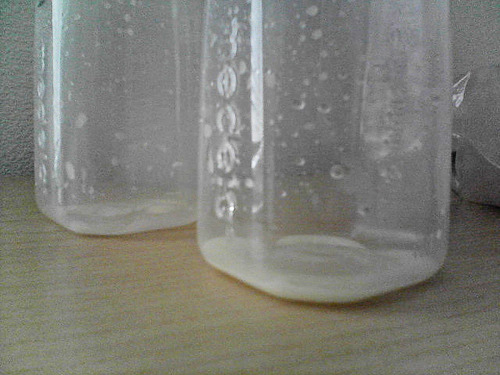Image credit: Mrs. Flinger on flickr
Introduction
Milk supply normally varies somewhat throughout the day and over weeks and months. As long as baby is allowed to nurse on cue, your milk supply will typically accommodate baby’s needs. However, when you are pumping part-time or full-time, pumping output can become an issue due to a few factors:
- The ability to measure how much milk you are pumping makes any decrease in pumping output more obvious and more worrying, even when it’s a normal variation.
- You generally need to pump x amount of milk for baby for a particular day, and it can be quite stressful when you do not pump this amount.
- No pump can remove milk from the breast as well as an effectively nursing baby, so pumping does not maintain milk supply as well as a nursing baby. Because of this, the greater the percentage of baby’s nourishment provided by pumping (rather than direct breastfeeding), the greater the possibility that you may have to work harder to maintain supply.
What is normal when it comes to pumping output and changes in pumping output?
It is typical for a mother who is breastfeeding full-time to be able to pump around 1/2 to 2 ounces total (for both breasts) per pumping session. Mothers who pump more milk per session may have an oversupply of milk, or may respond better than average to the pump, or may have been able to increase pump output with practice. Many mothers think that they should be able to pump 4-8 ounces per pumping session, but even 4 ounces is a rather large pumping output for a mom who is breastfeeding full-time.
It is not unusual to need to pump 2-3 times to get enough milk for one feeding for baby (remember that the pump cannot get as much milk as a baby who nurses effectively).
Many mothers are able to pump more milk per session when they are separated from baby or if they are exclusively pumping. Milk pumped when you are breastfeeding full-time is “extra” milk — over and beyond what baby needs. Don’t get discouraged if you are trying to build up a freezer stash when breastfeeding full time and don’t get much milk per pumping session — this is perfectly normal and expected.
It is very common to have more milk than baby needs in the early weeks, which regulates down to baby’s needs over the first few weeks or months. When your milk supply regulates (this change may occur either gradually or rather suddenly), it is normal for pumping output to decrease. For moms who have oversupply, this change often occurs later (6-9+ months postpartum rather than 6-12 weeks).
It is normal for pumping output to vary from session to session and day to day. Having an occasional low volume day is not unusual.
During a growth spurt, don’t be surprised if baby drinks more expressed milk than usual, making it harder for mom to provide enough expressed milk. Growth spurts are temporary – try increasing nursing and adding a pumping session or two until the growth spurt is over.
Menstruation or ovulation can result in a temporary drop in milk supply. You might also notice cyclical dips in milk supply before your period returns, as your body begins the return to fertility. Hormonal changes also cause milk supply to decrease during pregnancy.
Remember that the amount of milk that you pump is not a measure of the milk supply available to your baby at the breast!
What can cause a decrease in pumping output?
First, consider the possibility that baby is being overfed by bottle when you and baby are separated. If this is the case, you may actually not need to be expressing as much milk as is being requested. This is certainly not always the case, but it is not at all uncommon. See How much expressed milk will my baby need? for additional information.

Image credit: Jerry Bunkers on flickr
When you do need to pump more milk, the first thing to check is your pump:
- Are you using an appropriate pump for the amount of pumping that you do?
- How old is your pump? If you have an older electric pump (particularly older than a year), or if you are pumping more often than the pump was designed for, the motor may be wearing out.
- Many times a decrease in pumping output is because pump parts need to be replaced. Have you checked your pump and replaced any parts that are worn or that haven’t been replaced in the last 3-6 months?
- Do you have a type of pump (check your user manual) that benefits from occasionally boiling the boilable parts?
- Switching to a larger pump flange makes a difference in pumping comfort and/or output for some moms. See Choosing a Correctly-Fitted Breastshield for more information.
Supply-demand cycle:
- Have you reduced the number of pumping or nursing sessions recently, or cut back on nursing/pumping in other ways? Milk production is a demand-supply process. More nursing/pumping results in a greater milk supply. If you consistently decrease nursing or pumping for several days, your overall milk supply will decrease and you can expect to see a decrease in pumped amounts.
- Has baby started solids recently? As baby eats more solids and takes in less milk, overall milk supply naturally decreases and you may see a decrease in pumping output. You may not notice a change in nursing pattern, as some babies nurse just as often, but take in less milk during those sessions. If baby started solids early (before around 6 months) or is eating lots of solids early on, you are more likely to notice a drop in supply. A very gradual start to solids around 6 months or later is less likely to affect milk supply.
Hormonal causes of decreased milk supply:
- Have you started hormonal birth control recently? Hormonal birth control, particularly that containing estrogen, can significantly decrease milk supply.
- Are you expecting either ovulation or your period soon, or has it recently started?
- Are you pregnant?
Taking care of mom:
- Have you started a strict diet? Are you getting enough calories? Snacking during the day on healthy, protein-rich foods may be helpful.
- Are you drinking to thirst? Some moms, particularly when they are at work, will get busy and forget to drink enough fluids.
- Are you getting enough rest? This can be hard to do when you have a baby. Try to go to bed a little earlier and to take a nap each day on your days off. Consider co-sleeping so you can get more sleep. Just a little added rest may make a big difference.
- Have you been under an unusually large amount of stress? Stress can affect let-down and pumping output.
- Have you been sick? Illness, especially if you have a fever, mastitis or get dehydrated, can result in a temporary decrease in milk supply. Some medications can also decrease milk supply (hormonal birth control, pseudoephedrine, ethanol/alcoholic beverages, bromocriptine, ergotamine, cabergoline…).
See also Hidden Hindrances to a Healthy Milk Supply
How can I increase pumping output?
To speed milk production and increase overall milk supply, the key is to remove more milk from the breast and to do this frequently, so that less milk accumulates in the breast between feedings.
Increasing frequency
- Nurse more often when you are with your baby.
- Are you pumping frequently enough? Is there any way you can add a pumping session at work? If necessary, when pumping times are very limited, adding even a short 5 minute pumping session is better than not pumping at all.
- Add a pumping session or two outside of work hours or on the weekend. Try pumping after baby nurses, or pump one side while baby nurses on the other side. You might also try pumping while baby is napping, at night, or when baby goes longer than usual between nursings.
- Does your baby complain about slower milk flow when you pump between nursings? If so, try single pumping between nursings, instead of double pumping. Although single pumping is not as effective for increasing milk supply, this leaves one breast more full, so the milk will flow more quickly. See also these tips for babies who want a faster milk flow.
- Try cluster pumping, instead of a regular nursing/pumping session. Sit down with your baby and your pump, and nurse and pump every half-hour to hour for several hours.
- Some moms find it helpful to do a 2-3 day long power pump every couple of weeks to “super charge” their milk supply. This is simply a nursing vacation with pumping added in. On these days, get lots of rest, nurse very frequently and pump after as many nursing sessions as possible.
Removing more milk from the breasts
- Are you pumping long enough? When pumping to increase milk supply, it’s recommended that you (double) pump for at least 15 minutes; to ensure that the pump removes an optimum amount of milk from the breast, keep pumping for 2-5 minutes after the last drops of milk. If you don’t always have time to pump this long, remember that adding even a short pumping session (increasing frequency but perhaps not removing milk thoroughly) is helpful.
- Use a good double pump. Double pumping generally results in better pumping output and is better for maintaining milk supply. Pump quality can make a huge difference in pumping output, and different moms have better results with different pumps. However, some moms with abundant milk supplies do not respond well to pumping (even using the best of pumps) and do not get much milk when pumping. These moms may get better results using manual expression.
- Use breast massage and breast compression.
- If your pump has a soft shield or shield insert available (for example, the Medela Comfort breastshield or the Ameda Flexishield insert), then try using the pump with and without it. Some moms get better results with the softer shield; some get better results without it.
- Switching to a larger pump flange increases pumping output for some moms. Scroll down here for more information on sizing the flange.
Galactagogues
- Many working and pumping moms have found that eating oatmeal and staying hydrated is very helpful for increasing pumping output. It can be helpful to snack on protein-rich foods during the day and to have something to drink every time you sit down to pump or breastfeed.
- Many moms have gotten good results using fenugreek or other herbs to increase supply, either on a short- or long-term basis. This is most effective when combined with increased nursing/pumping.
Other things to try
The following things are useful for maximizing nursing and minimizing the amount of expressed milk that baby needs while you are away.
Nurse right before you leave baby and immediately after you return from work. Make sure your care provider does not feed baby right before you are due to return.
Has your baby started solids? If so, have your care provider offer all (or most) solids, and only (or mainly) breastfeed when you are with baby. By doing this, baby may need less milk when you are apart (due to the solids) and will nurse more when you are together. This can both help your supply (more nursing) and decrease the amount of pumped milk you need to provide.
Encourage baby to “reverse cycle” – reverse cycling is when baby nurses frequently when mom and baby are together (usually at night) and takes little milk when mom & baby are separated.
One study has shown that the moms of hospitalized babies who listened to guided relaxation or soothing music while pumping had an increased pumping output. When mom listened to a recording that included both music and guided relaxation while pumping, in addition to looking at photos of her baby, pumping output was increased even more. In this study, the interventions led to moms producing 2-3 times their normal pumping output. Milk fat content also increased for these moms in the early days of the study.
Additional information
Increasing Low Milk Supply @KellyMom
Let-down Reflex: Too slow? @KellyMom
How Much Milk Should You Expect to Pump? by Nancy Mohrbacher, IBCLC, FILCA
What to Expect When Pumping by Paula Yount
How much expressed milk will my baby need? @KellyMom
To Pump More Milk, Use Hands-On Pumping by Nancy Mohrbacher, IBCLC, FILCA
Breastpumps – troubleshooting and general info @KellyMom
Ouch! What If Pumping Hurts? by Nancy Mohrbacher, IBCLC, FILCA
Working & Pumping Tips @KellyMom
See the Working, Pumping, Bottle Feeding menu for information on formula and other foods
Keith DR, Weaver BS, Vogel RL. The effect of music-based listening interventions on the volume, fat content, and caloric content of breast milk-produced by mothers of premature and critically ill infants. Adv Neonatal Care. 2012 Apr;12(2):112-9.


